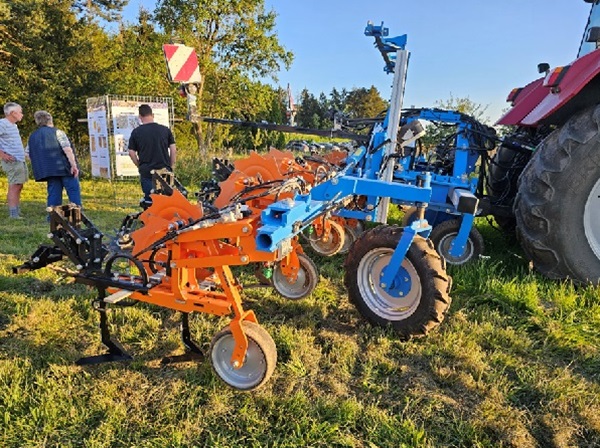 Mechanical weeding apparatus for maize drills;
Credit: Chronicle.lu
Mechanical weeding apparatus for maize drills;
Credit: Chronicle.lu
On Tuesday 27 August 2024, at a field on a plateau above Lorentzweiler, the Water Service of the Ville de Luxembourg in collaboration with the Institute for Biological Agriculture and Agroecology Luxembourg (IBLA) demonstrated the results of a pilot study into the sustainable cultivation of land that falls within designated subterranean water protection zones.
The study has aimed to find ways in which to minimise erosion of the topsoil by reducing the number of weeds, and with that the number of times that it is necessary to remove them, and to protect the soil through the careful selection of companion crops, and their planting time. Key constraints are that any proposed practices need to be scaled up to a commercial operation, and that as few herbicides or fertilisers as possible be used in the process, thus as much weeding as possible is done mechanically, which can be detrimental to the crops and the topsoil if done too frequently or aggressively. An additional aim was to reduce the amount of leaching of nitrates through the soil into the water table.
The pilot project was initiated in 2022 and sought to establish the difference between growing maize on its own or accompanying it with runner beans undersown as a companion crop. This particular target research comes about as a result of the recent tendency towards very wet springs and very dry summers, which has diminished the yield and the quality of the maize, which is grown as winter cattle feed. Runner beans were chosen as the companion crop owing to their high protein content, which augments the increasingly variable protein yield from the maize to the benefit of livestock production. An additional factor that was taken into consideration was the sowing time, and the results suggest that owing to the maize growth being stunted by cooler weather, a later sowing allows for a more uniform growth rate, and with it a quicker establishment of a canopy of leaves to reduce the amount and speed of weed growth.
The Ville de Luxembourg established a Regional Collaboration Committee (CCR Région VdL) in partnership with the neighbouring communes of Lintgen, Lorentzweiler, Steinsel and Strassen and collectively acquired specialist mechanical hoeing and harrowing equipment, which can be seen attached to the tractor in the title picture. Tests were done both with partial herbicide (within the rows) and mechanical weeding between the rows, which resulted in a 70% reduction in herbicides, and also with a purely mechanical process.
The initial results are promising, with particularly an increase in the quality of the topsoil, reduction in erosion, improvement of the quality and growth of the maize and a significant reduction in the use of nitrate fertilisers. As a result, the collaboration and the research will continue, and the parties are currently in discussion with the government to solicit state aid for the project.








